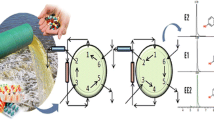Abstract
This paper describes analysis of steroid estrogens (estrone, estradiol, estriol, and 17α-ethynylestradiol) in river sediment using high performance liquid chromatography (Perkin Elmer FX15) electrospray ionization-mass spectrometry. River sediment samples were prepared by ultrasonic extraction with methanol-dichloromethane, followed by solid phase extraction involving C18 SPE cartridge (500 mg/6 cc). Dissolution was performed using ethyl acetate and methanol, and elution was performed with methanol in ethyl acetate (15 % v/v). The extracts were analyzed by HPLC–MS/MS in multiple reaction monitoring and negative modes with a Zorbax C18 column. Elution was carried out with a gradient of 0.2 % formic acid and methanol with 0.2 % formic acid. The recovery rates from river sediment samples ranged from 90 to 114 %, with relative standard deviations in the range 0.8–17 %. Limit of quantification was determined at 0.02 µg/L all the investigated steroid estrogens. Linear regression analysis was performed for concentrations ranging between 0.02 and 200 µg/L. Coefficient of determination values of more than 0.996 were obtained for all the standard solution calibrations. The method was successfully applied to identify the target analytes in river sediment collected from Langat River (Malaysia) at concentrations of microgram-per-gram in sediment.




Similar content being viewed by others
References
Aris AZ, Shamsuddin AS, Praveena SM (2014) Occurrence of 17α-ethynylestradiol (EE2) in the environment and effect on exposed biota: a review. Environ Int 69:104–119. doi:10.1016/j.envint.2014.04.011
Barel-Cohen K, Shore LS, Shemesh M, Wenzel A, Mueller J, Kronfeld-Schor N (2006) Monitoring of natural and synthetic hormones in a polluted river. J Environ Manage 78:16–23. doi:10.1016/j.jenvman.2005.04.006
Baronti C, Curini R, D’Ascenzo G, Di Corcia A, Gentili A, Samperi R (2000) Monitoring natural and synthetic estrogens at activated sludge sewage treatment plants and in a receiving river water. Environ Sci Technol 34:5059–5066. doi:10.1021/es001359q
Cullum N (2013) Analysis of steroid residues in wastewater. Anglian Water Services, Hungtingdon
Hájková K, Pulkrabová J, Schůrek J, Hajšlová J, Poustka J, Nápravníková M, Kocourek V (2007) Novel approaches to the analysis of steroid estrogens in river sediments. Anal Bioanal Chem 387:1351–1363. doi:10.1007/s00216-006-1026-9
Jemal M, Ouyang Z, Teitz DS (1998) High performance liquid chromatography mobile phase composition optimization for the quantitative determination of a carboxylic acid compound in human plasma by negative ion electrospray high performance liquid chromatography tandem mass spectrometry. Rapid Commun Mass Spectrom 12(8):429–434
Jürgens MD, Williams RJ, Johnson AC (1999) Fate and behaviour of steroid oestrogens in rivers: a scoping study. R&D Technical Report P161. Environment Agency, Bristol
Koh YKK, Chiu TY, Boobis A, Cartmell E, Lester JN, Scrimshaw MD (2007) Determination of steroid estrogens in wastewater by high performance liquid chromatography-tandem mass spectrometry. J Chromatogr A 1173:81–87. doi:10.1016/j.chroma.2007.09.074
Koren L, Ng ESM, Soma KK, Wynne-Edwards KE (2012) Sample preparation and liquid chromatography-tandem mass spectrometry for multiple steroids in mammalian and avian circulation. PLoS One 7:e32496. doi:10.1371/journal.pone.0032496
Kuster M, De Alda MJ, Barceló D (2004) Analysis and distribution of estrogens and progestogens in sewage sludge, soils and sediments. TrAC Trends Anal Chem 23:790–798. doi:10.1016/j.trac.2004.08.007
Lai KM, Johnson KL, Scrimshaw MD, Lester JN (2000) Binding of waterborne steroid estrogens to solid phases in river and estuarine systems. Environ Sci Technol 34:3890–3894. doi:10.1021/es9912729
l-Odaini NA, Zakaria MP, Yaziz MI, Surif S, Kannan N (2013) Occurrence of synthetic hormones in sewage effluents and Langat River and its tributaries, Malaysia. Int J Environ Anal Chem 93:1457–1469. doi:10.1080/03067319.2012.727810
López de Alda MJ, Gil A, Paz E, Barceló D (2002) Occurrence and analysis of estrogens and progestogens in river sediments by liquid chromatography-electrospray-mass spectrometry. Analyst 127:1299–1304. doi:10.1039/b207658f
Mikel C (2010) Letters to the editor a tale of two drug testing technologies: GC-MS and LC–MS/MS THE are independent medical examiners. Pain Phys 13:91–92.
Nováková L, Matysová L, Solich P (2006) Advantages of application of UPLC in pharmaceutical analysis. Talanta 68:908–918. doi:10.1016/j.talanta.2005.06.035
Peck M, Gibson RW, Kortenkamp A, Hill EM (2004) Sediments are major sinks of steroidal estrogens in two United Kingdom rivers. Environ Toxicol Chem 23:945–952. doi:10.1897/03-41
Peng X, Wang Z, Yang C, Chen F, Mai B (2006) Simultaneous determination of endocrine-disrupting phenols and steroid estrogens in sediment by gas chromatography-mass spectrometry. J Chromatogr A 1116:51–56. doi:10.1016/j.chroma.2006.03.017
Ternes TA, Stumpf M, Mueller J, Haberer K, Wilken RD, Servos M (1999) Behavior and occurrence of estrogens in municipal sewage treatment plants—I. Investigations in Germany, Canada and Brazil. Sci Total Environ 225:81–90. doi:10.1016/S0048-9697(98)00334-9
Ternes TA, Andersen H, Gilberg D, Bonerz M (2002) Determination of estrogens in sludge and sediments by liquid extraction and GC/MS/MS. Anal Chem 74:3498–3504. doi:10.1021/ac015717z
Zhang R, Tang J, Li J, Cheng Z, Chaemfa C, Liu D, Zheng Q, Song M, Luo C, Zhang G (2013) Occurrence and risks of antibiotics in the coastal aquatic environment of the Yellow Sea, North China. Sci Total Environ 450–451:197–204. doi:10.1016/j.scitotenv.2013.02.024
Zhang Z, Ren N, Kannan K, Nan J, Liu L, Ma W, Qi H, Li Y (2014) Occurrence of endocrine-disrupting phenols and estrogens in water and sediment of the Songhua River, Northeastern China. Arch Environ Contam Toxicol 66:361–369. doi:10.1007/s00244-014-9998-5
Zhao J-L, Ying G-G, Chen F, Liu Y-S, Wang L, Yang B, Liu S, Tao R (2011) Estrogenic activity profiles and risks in surface waters and sediments of the Pearl River system in South China assessed by chemical analysis and in vitro bioassay. J Environ Monit 13:813–821. doi:10.1039/c0em00473a
Acknowledgments
The authors would like to thank the Kurita Water Research Grant (Japan) for funding with vote number 6385300.
Author information
Authors and Affiliations
Corresponding author
Rights and permissions
About this article
Cite this article
Praveena, S.M., Hamin, N., Razak, S.Q.N.A. et al. Analysis of Steroid Estrogens in River Sediment by High Performance Liquid Chromatography-Electrospray Ionization-Mass Spectrometry. Iran J Sci Technol Trans Sci 42, 525–532 (2018). https://doi.org/10.1007/s40995-016-0109-5
Received:
Accepted:
Published:
Issue Date:
DOI: https://doi.org/10.1007/s40995-016-0109-5




